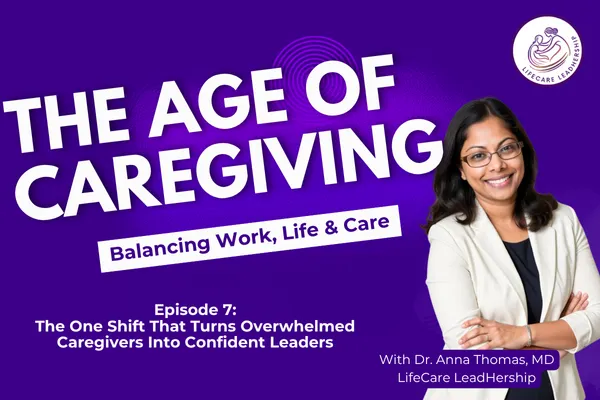
The One Shift That Turns Overwhelmed Caregivers Into Confident Leaders
When Caregiving Feels Like Too Much
“I don’t know how much longer I can do this…”
If you’ve ever whispered that to yourself during a difficult caregiving season, you are not alone. Caregiving doesn’t always feel noble or heroic—it often feels heavy. It can feel like you’re barely holding everything together, disappearing behind the appointments, responsibilities, and emotions.
But there is one powerful mindset shift—just one—that can change how you experience caregiving.
It’s not about adding more tools or doing more.
It’s about how you see yourself.
The Shift: From Helper to Leader
Stop seeing yourself as just a helper.
Start seeing yourself as a leader.
Not because you have every answer. Not because someone gave you a title.
But because what you’re doing—every single day—is leadership at its most raw and real.
You are coordinating care. Managing emotions. Navigating calendars, crises, and conflicts. You’re advocating. Planning. Protecting.
That’s not just helping.
That’s leading.
Why This Shift Matters
Most caregivers—especially women—don’t view themselves as leaders.
Instead, they feel:
Exhausted
Guilty
Invisible
Unprepared
Behind
Caregiving doesn’t hand out leadership titles. It hands out overwhelm.
And yet, in the middle of all that, you’re doing the work of leadership.
The problem is: no one ever told you that’s what this is.
And how we see ourselves shapes how we show up.
Step 1: Redefine What Leadership Looks Like
In traditional environments, leadership means public visibility, bold decisions, and confident direction.
In caregiving, leadership means something different:
Sitting with someone in pain without trying to fix it
Choosing compassion over correction
Saying “no” when you’re overwhelmed
Advocating when systems push back
Asking for help even when it’s hard
That’s grounded, relational leadership. And it matters.
Step 2: Replace Guilt with Intention
Guilt thrives on the question, “Am I doing enough?”
Even after managing appointments, meals, medications, and a full-time job, most caregivers still wonder:
Did I forget something? Was I patient enough? Could I have done more?
But guilt doesn’t go away when we do more. It fades when we ask better questions:
Am I leading this day with intention?
Did I protect what matters?
Did I show up with presence, even in imperfection?
Confidence doesn’t come from doing it all—it comes from leading with clarity and care.
Step 3: Lead From the Middle, Not the Mountaintop
You don’t need to be finished or perfect to lead.
Most caregiving leadership happens in the middle—while you’re still figuring things out.
You don’t need to know everything. You just need to take the next right step.
That might look like:
Being honest with your family about your limits
Writing a care plan, even if it changes
Creating a simple rhythm that grounds you
Saying “I’m still figuring this out” while still moving forward
Leadership isn’t about perfection. It’s about purpose and persistence.
A Real Story of Transformation
One of my Thrive & Lead coaching clients came to me in burnout. She was caring for her mother after a stroke while working a demanding job. She told me, “I’m failing at everything.”
We didn’t start with a checklist. We started with identity.
We reframed her role as “Care Leader.”
We created space for daily reflection.
We wrote scripts to set boundaries with her siblings.
We built systems that worked with her energy—not just her calendar.
Weeks later, her tone had changed from “I’m overwhelmed” to “I’m leading through something difficult—and I’m doing it with heart.”
That’s what I want for you.
Your Next Steps
If this message resonates with you, here’s how to begin your shift from overwhelmed caregiver to confident Care Leader:
✅ Free Workshop – From Caregiver to Care Leader
Gain clarity, build a leadership mindset, and take your next steps forward.✅ Book – Balancing Care While Working
A guidebook for working caregivers ready to reclaim time, energy, and purpose.✅ Book – Dementia Care Confidence
Especially helpful if your caregiving involves dementia-related challenges.✅ Courses & Coaching – Thrive & Lead Program
For caregivers who want systems, structure, and support to lead their care journey with strength and sanity.✅ Corporate & Organizational Support
If you're a leader looking to support employees or teams through caregiving challenges.
You can explore more resources at LifeCareLeadHership.com.
Explore More from The Age of Caregiving™
🎧 Listen on Buzzsprout: https://www.lifecareleadhership.com/podcast
📺 Watch on YouTube: https://www.youtube.com/@ageofcaregiving
📝 Read more on our Blog: https://lifecareleadhership.com/ageofcaregiving
Final Word
You don’t need someone else to validate your role.
You need to claim it.
Because caregiving isn’t just a role—it’s a form of leadership.
And you, my friend, are already doing it.
Now it’s time to do it with intention.
You’ve got this.
And I’ve got you.
The views and opinions expressed in this post are solely my own and do not reflect the views of any past or present employer of Dr. Thomas. This content is for educational and informational purposes only and is not intended as medical or legal advice.
